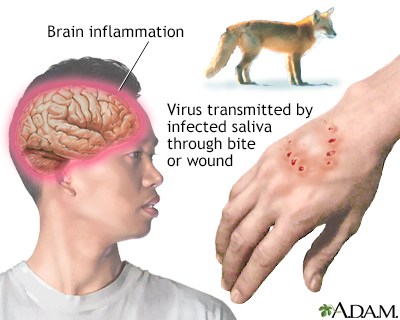Rabies

What is Rabies?
Rabies is a deadly viral infection that affects the central nervous system of mammals, including humans. It is transmitted primarily through the bite of an infected animal, such as a dog, bat, raccoon, or fox. The rabies virus attacks the brain and spinal cord, leading to severe neurological symptoms and, ultimately, death if left untreated.
Who's at risk for Rabies?
People at risk for rabies include those who live in or travel to areas with high rates of the disease, individuals who work with animals or wildlife, and anyone who may come into contact with infected animals, such as veterinarians or animal control workers. Children are also at increased risk due to their tendency to approach animals and their potential inability to report bites or scratches.
What causes Rabies?
Rabies is caused by the rabies virus, a member of the Lyssavirus genus. The virus is primarily transmitted through the saliva of infected animals, typically via a bite or, less commonly, a scratch. It can also be contracted through contact with infected saliva or neural tissue on open wounds or mucous membranes, such as the eyes, nose, or mouth.
How does Rabies start?
Rabies infection begins when the virus enters the body through a bite or other exposure to infected saliva or neural tissue. The virus then travels through the nerves to the spinal cord and brain, where it multiplies and causes inflammation, leading to the development of severe neurological symptoms.
What are the symptoms of Rabies?
Initial symptoms of rabies may include fever, headache, muscle aches, and fatigue. As the infection progresses, symptoms may become more severe and include anxiety, confusion, hallucinations, difficulty swallowing, hypersalivation, hydrophobia (fear of water), and paralysis. Once neurological symptoms appear, the disease is almost always fatal.
How is Rabies diagnosed?
Rabies is typically diagnosed based on a combination of clinical signs, exposure history, and laboratory tests. In animals, the definitive diagnosis is made by testing brain tissue for the presence of the virus. In humans, a series of tests may be performed, including saliva, blood, cerebrospinal fluid, and skin biopsies, though these tests are often less reliable, especially in the early stages of the infection.
How can Rabies be treated?
Once symptoms of rabies appear, there is no effective treatment, and the infection is almost always fatal. However, if exposure to the rabies virus is suspected, immediate medical attention and post-exposure prophylaxis (PEP) can prevent the development of the disease. PEP consists of a series of vaccinations and, in some cases, the administration of rabies immune globulin.
What complications may occur with Rabies?
Complications associated with rabies infection include severe neurological damage, coma, and death. Due to the high fatality rate and rapid progression of the disease, it is critical to seek medical attention immediately if there is any suspicion of exposure to the rabies virus.
How can I prevent Rabies?
Rabies prevention involves avoiding contact with potentially infected animals, vaccinating pets against the disease, and seeking immediate medical care following a bite or scratch from an animal that may carry the virus. In some cases, pre-exposure vaccination may be recommended for people at high risk of exposure, such as veterinarians, wildlife workers, or travelers to areas with high rabies prevalence.
Long-term management of Rabies
As there is no effective treatment for rabies once symptoms appear, long-term management is not applicable. The focus remains on prevention, early detection, and immediate intervention following potential exposure to the virus.
What is recent research saying about Rabies?
Recent research on rabies has focused on improving vaccination strategies, developing more effective diagnostic methods, and investigating new treatment approaches, such as antiviral medications and novel immunotherapies. Additionally, researchers are working on understanding the molecular mechanisms of the rabies virus and its interaction with the host immune system, which may lead to innovative therapies in the future.
Where can I go for more information on Rabies?
For more information on rabies, consult your healthcare provider or visit reputable websites like the Centers for Disease Control and Prevention, the World Health Organization, or the Global Alliance for Rabies Control.

